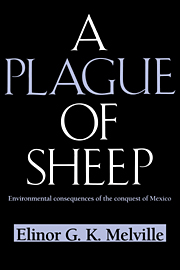Book contents
- Frontmatter
- Contents
- Illustrations and Tables
- Preface
- Chapter 1 Introduction
- Chapter 2 Alien Landscapes
- Chapter 3 The Australian Experience
- Chapter 4 The Mexican Case
- Chapter 5 The Conquest Process
- Chapter 6 The Colonial Regime
- Appendix A Sub-Areas
- Appendix B Population Estimates
- Appendix C Sources for Land Holding and Land Use
- Abbreviations
- Glossary
- Bibliography
- Index
Chapter 5 - The Conquest Process
Published online by Cambridge University Press: 05 August 2012
- Frontmatter
- Contents
- Illustrations and Tables
- Preface
- Chapter 1 Introduction
- Chapter 2 Alien Landscapes
- Chapter 3 The Australian Experience
- Chapter 4 The Mexican Case
- Chapter 5 The Conquest Process
- Chapter 6 The Colonial Regime
- Appendix A Sub-Areas
- Appendix B Population Estimates
- Appendix C Sources for Land Holding and Land Use
- Abbreviations
- Glossary
- Bibliography
- Index
Summary
Up to this point we have taken for granted that the Spaniards introduced their animals into the New World ecosystems and that they acquired access to the pasture and water necessary to maintain their flocks; but in neither case was this a foregone conclusion arising from their presence in the New World, nor even of their defeat of the Aztec Empire. Rather, the acquisition by the Spaniards of rights, first to grass and water and later to land, was an inherent part of the conquest process.
The most obvious means by which the Spaniards acquired access to resources was force; but force in and of itself is not sufficient explanation of the process of Spanish conquest and domination. Force was used and battles were fought, but in many cases the Spanish takeover occurred without the use of organized force, and the battles were more often than not fought in the court room. To a surprising degree the Spaniards' actions in the New World were constrained (if not always restrained) by laws and customs that shaped the processes by which they acquired resources – and thus their relationships with the indigenous populations. The application of Spanish law was not straightforward, however. The New World context warped the application of the law, distorting the intent of rulings, making loopholes for opportunists. The successful application of the law required knowledge that the Indians did not have at first, and in any case there was virtually no police force.
- Type
- Chapter
- Information
- A Plague of SheepEnvironmental Consequences of the Conquest of Mexico, pp. 116 - 150Publisher: Cambridge University PressPrint publication year: 1994



